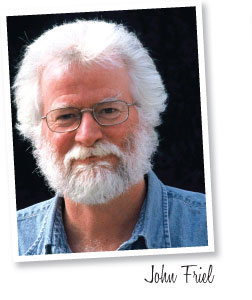11/1/2021
The Edible Environment
John Friel

The Perennial Plant Association held another “Pop-Up” mini symposium in October on the lovely island of Martha’s Vineyard, a Great Gatsby sort of place where tourists go to play, and the wealthy and famous go to rub elbows with one another and to roll their eyes at tourists. The Obamas have a home there and I’m willing to bet it’s not among the Top 20 nicest houses.
I went because A) it was a PPA event, always a good time; and B) it was a mere eight-hour drive, practically just around the corner, right?; and C) because I’d heard many glowing reports of Martha’s Vineyard.
For PPA, the event was pretty light on perennials, heavy on trees, but nonetheless intriguing and informative. At one stop I joked to another attendee, “Look! I found the perennial!” Which was an unfair exaggeration, of course, but seriously, this was a very woodsy day.
I’ve attended many PPA tours, but only at Mytoi have I seen the skull of a North Atlantic Right Whale guarding the gate. A large, impressive object. Whales are not a common sight in my native, mostly-landlocked Pennsylvania. Right whales aren’t a common sight even in New England, once the world capital of whaling. There are thought to be fewer than 400 left. This one washed up dead at a lighthouse in 2017, probably T-boned by a large ship.
Mytoi is a serene, lovely Japanese garden on Chappaquiddick Island. If you’re young enough that the island’s name rings only a faint bell, or none at all, Mytoi is right up the road from the wooden bridge where in 1969 a young woman’s life and Ted Kennedy’s presidential chances ended abruptly. RIP Mary Jo.
Since this is the edibles issue, did you know you can eat the fruit of a Korean dogwood, Cornus kousa? I didn't and neither did most of the other folks on the tour. We learned this from Tim Boland, Executive Director of lovely Polly Hill Arboretum, which had more perennials than I’d expected to find in a tree conservatory. It wasn’t very good; the texture was like a thin, goopy custard, without much flavor, wrapped in a papery, unappetizing skin. Maybe I didn’t choose my samples at the correct stage of ripeness.
Our tour guides were Chris Wiley, a PPA Board member, and her husband Chuck. They own Vineyard Gardens, where there were many, many perennials, all well-grown and meticulously labeled. Chuck turned us on to the fact that you can also eat the fruit of the Russian olive, Eleagnus angustifolia, which was growing wild beside the road. It’s a very small berry and you’d need to eat many fistfuls (and spit out many seeds) to come close to a meal’s worth. But it was a fun fact to learn and they were actually rather tasty.
Previously, I had only known Russian olive as an invasive weed growing alongside tamarisk (Tamarix ramosissima) in the Grand Canyon. Together, these two Eurasian invaders crowd out, shade out and out-compete native vegetation. Yearly, they siphon hundreds of thousands of acre-feet of precious water out of the Colorado River. Maybe spitting out those seeds wasn’t the right thing to do with them. Birds like the berries, too, with the inevitable result that they help spread the infestation when the seeds leave their digestive systems.
The idea of eating invasive species is an odd ally of foodscaping. Wild foragers who call themselves “invasivores” tout it as a way to fight the onslaught of obnoxious organisms like snakehead fish, feral pigs, Asian carp, nutria, kudzu, Japanese knotweed and more. It seems improbable that we could eat our way out of the many problems such unwelcome guests—many of which were deliberately introduced, of course—cause. But it certainly can’t hurt, so if it sounds like it might be your thing, you can learn much more—including nutria stew recipes—at eattheinvaders.org or cantbeatemeatem.us.
Every little bit helps. As the sparrow said, lying on his back with his spindly legs raised because he’d heard the sky was falling, “One does what one can.” GP
John Friel is marketing manager for Emerald Coast Growers and a freelance writer.